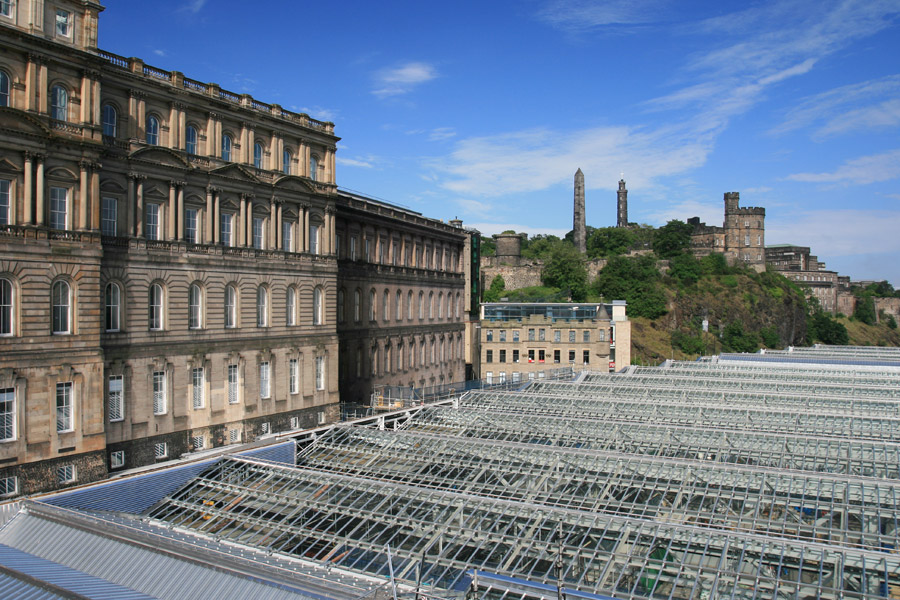

Dingwall Castle, or Dingwall’s Castle, was the Edinburgh residence of Sir John Dingwall in the 16th century, but nothing of it now remains.
The early history of Dingwall Castle isn’t known. It has been supposed by some that it was built by Sir John Dingwall, the Provost of Trinity College Church from 1525 to 1532, who was appointed a Lord of Session in 1532 upon the foundation of the College of Justice. However since the castle was in ruins by the mid-17th century it seems that it more than likely had an older origin.
It stood in the vicinity of the building now known as Waverley Gate, formerly the General Post Office, although the exact location is unclear. Some time between the late 16th century and the mid-17th century the castle became ruined, suggesting perhaps that it dated to earlier than the 16th century.
It is depicted on a James Gordon map from 1647 as a large, square courtyard castle, with a round tower at each corner, except for the north-east corner where the outer half of the tower is missing. The style of the castle on the map backs up the theory that it pre-dated the 16th century.
It stands in a large plot of land at the northern extremity of Edinburgh, and the plot is surrounded by a wall. At the south-east corner of the plot is the Trinity College Church.

Comparing the position of the Trinity College Church to the corner of Calder Road as it curves around the bottom of the rocky crags below what is now Old Calton Cemetery, and the position of the castle in relation to the church, and also to the Nor’ Loch (later drained, and now Princes Street Gardens), it would seem that Dingwall’s Castle must have stood slightly further north than it is listed by the RCAHMS (grid reference NT 2590 7394).
Why the castle fell into ruins is unclear, but when Edinburgh was under siege between 1571 and 1573, Dingwall’s Castle was used first as a blockhouse, then later as a prison, and this may well have hastened its demise.
It would probably have required a significant investment to return the castle to a state fit for an important gentleman, but also in the late 16th and early 17th centuries tastes changed from castle living to the more fashionable mansion houses and townhouses.
Some of the stones from the castle were apparently used for the repair of Trinity College Church in 1643. Between 1734 and 1736 an Orphan Hospital (later renamed the Dean Hospital) was built close to the west end of the Trinity College Church on land named “Dingwall”.
It seems to have been concluded by some authors in the past that this meant that the Orphan Hospital was built on the actual site of the castle. However I believe that the Hospital was probably built within the castle plot rather than on the actual site of the castle itself.
With the expansion of the railways, the site was cleared in 1845, and the site of the Orphan Hospital and the Trinity College Church are both shown on an Ordnance Survey town plan of Edinburgh from 1852.

If Gordon’s map is relatively accurate, the position of the north bank of the Nor’ Loch in relation to the castle suggests that the castle stood approximately in line with modern day Princes Street, or possibly slightly south of it. This would place it either directly under Waterloo Place, or again just to the south of it.
In Cassell’s “Old and New Edinburgh” it mentions that sections of the castle’s walls could be seen amongst the foundations of the buildings of Shakespeare Square when they were demolished in 1860 to make way for the new General Post Office building, which was begun in 1861.
This piece of history is repeated in “Modern Edinburgh”, which places the site of Dingwall’s Castle to the south of Mutrie’s Hill. Mutrie’s Hill was an old village that was just outside Edinburgh and the site of which is now occupied by the modern St. James Square.
On the southern side of Mutrie’s-hill, and still nearer the old town, stood an ancient fortalice, called Dingwall’s Castle, as is believed, from John Dingwall, provost of Trinity College, and archdeacon of Caithness . . . . The last remains of the old castle only disappeared on the erection of Shakespeare-square, a portion of its walls being indeed believed to be still extant in one of the cellars there.
Modern Edinburgh
London, 1854
Again, this suggests that Dingwall’s Castle stood in the vicinity of today’s Waverley Gate building or Waterloo Place, rather than further south. The combination of Gordon’s map, and the accounts of the castle’s foundations being visible in what was Shakespeare Square, means I have placed the site of the castle just to the east of the old GPO.
Alternative names for Dingwall Castle
Dingwall's Castle
Where is Dingwall Castle?
Dingwall Castle is in the parish of Edinburgh and the county of Midlothian.
Grid reference: NT 2593 7397
Lat / long: 55.953023, -3.18773











